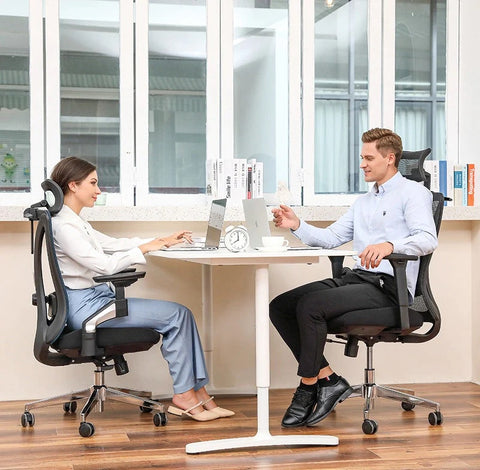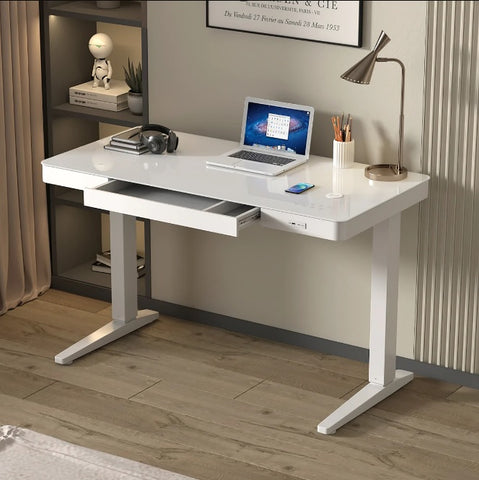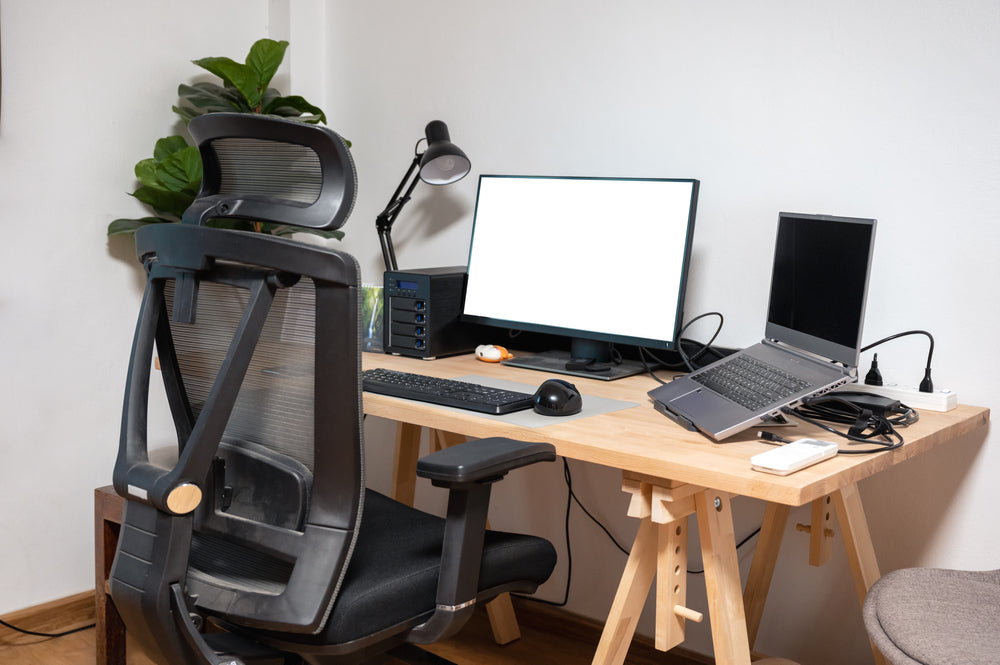
With more and more people choosing to work from home, having the best furniture to support you at work is a must-have. One of the most common medical problems is lower back pain. If you suffer from lower back pain or any other tension in your body after work, it could be a sign your posture is suffering.
Good posture might seem like a simple solution to maintaining back support, but it’s an important way to keep the spine and back healthy and critical to reducing back and neck pain. Aside from the way you sit, think about the furniture you’re using. Is it designed with your wellbeing in mind? Here, we’ll look at ergonomic adjustable chairs, desks and even mattresses that can help support your back night and day.
Problems caused by poor back support
When you’re working at a desk every day, the last thing on your mind is the way you’re sitting. With deadlines fast approaching and emails piling up — you’re not thinking about your posture. But poor posture can cause a number of health complications in the short-term and the future.
- Rounded shoulders
- Back and body aches and pains
- Muscle fatigue
- Obesity
- Headaches
- Stooped body shape
- Bent knees walking or standing.
If you spend the majority of your time during the day sitting in an office chair, here are some tips that will help you correct your posture.
Slouching
Slouching in your chair places strain on muscles, which can contribute to discomfort and pain. Don’t give in to the slouch. Work on getting into the habit of sitting correctly. The ideal position is your arms at a right angle with your wrists resting lightly on the desk. Your feet should sit flat on the floor while working at your desk. Knees should be in line with or slightly lower than your hips. If your feet don’t quite reach the floor, get a footrest to prevent your feet from dangling in the air. Be sure your back is flat against the back of your office chair and keep your shoulders straight.
The key to good posture is having all parts of your body balanced and supported. When standing, look in a full-length mirror from the side. You should be able to imagine a straight line from your ears, shoulder, hip, knee, and to the middle of your ankle.
Sitting all day is not natural. Don’t fall into the trap of being stuck to your office chair; get up and move around — and stretch if needed to release tension.

Standing
There are many benefits of a standing desk. You burn more calories, and standing while working can make you feel more productive and energised. But the way you stand is also important. Avoid standing with your weight on the heels; try to stand on the balls of your feet. When standing, ensure your feet are about shoulder-width apart with arms hanging naturally down the sides of your body.
For those unfamiliar with standing desks, the temptation can be to lock your knees and heels. Steer clear of this, as locked knees can cause lower back and leg pain. Ensure your knees are slightly bent, and wear supportive shoes if necessary.
Standing flat against a wall will give you a good idea of the best posture to adopt while standing. Your shoulders, bottom and head should touch the wall. For extended periods, shift your weight from one foot to the other, or transfer weight from your heels to your toes.
Investing in ergonomic office and home furniture can make achieving good posture easier. Read on to discover the best furniture for back support.
Ergonomic adjustable office chairs

We’ve established that the way you sit is integral for back support and maintaining good posture. Tension and stress in your back, shoulders and neck can put unnecessary strain on your body. The solution? Get an ergonomic adjustable office chair. Consider the following before purchasing to get the most out of your office chair:
Height adjustability — This one is top of our list. No two people are alike, so your chair needs to adapt to your preferences. Height adjustability is essential to ensure your feet rest flat on the floor and your screen is at eye height.
Lumbar support — Your lumbar spine stabilises the upper body and lower back. Adjustable lumbar support is critical, aiding in even weight distribution. This will reduce any areas of concentrated stress.
Seat width and depth — The standard seat size ranges from 17-20 inches. Ample space needs to be provided for thigh support. At least an inch of space on either side of your hips but not too wide. You don’t want your arms stretching out to touch the armrests. The perfect ergonomic office chair should be deep enough for you to sit with your back against the backrest. A couple of inches of space between the end of the chair and your knees is preferable.
Backrest — Your backrest should support the natural curve of your spine. Again, adjustability is important. Different reclining options will relieve tension in the lower back.
Armrests — Your armrests need to be broad and well placed to allow your elbows and forearms to rest comfortably on them while you work.
Choosing an adjustable office chair
Based on the above, our product recommendation is the Prima ergonomic chair. A mesh backrest keeps the air flowing and your back cool — contouring the body and ensuring your weight is spread evenly. High-quality foam padding cushions the hips, and the headrest, armrests, backrest, seat depth and height are fully adjustable. With superb lumbar support, this office chair is an instant ergonomic winner. The seat also slides out, allowing for customisable support as you work.
Height-adjustable desks
A height-adjustable desk and office chair are a match made in heaven. This way, you can tailor both to achieve the best level of back support. To work out which desk is best for you, read our helpful blog on choosing the right desk height. Your desk can do far more than support good posture. We’ve already looked at the benefits of a standing desk, but a smart standing desk has even more benefits.
Choosing a height-adjustable desk

So, what’s our pick for the ultimate height-adjustable desk? It's got to be this smart desk with adjustable height options. Featuring fast wireless, USB and USB-C charging ports, it is finished with a tempered glass top for a touch of elegance and style. What’s more, it’s whiteboard pen friendly, so you can jot down notes directly onto your desk with glass marker pens. Touch screen controls make this ergonomic office desk easy to use, and a sleek storage drawer ensures your trusty office accessories are well within reach.
Ergonomic extras
Sleep is essential for the body to recuperate and recover from the day’s activities. Good posture is also vital when you’re asleep. If your mattress is too hard or soft, your spine, neck and lower back won’t be adequately supported. That’s why choosing the right mattress for your back is crucial.
A medium-firm mattress is best for those who experience lower back pain or discomfort. Appropriate firmness also depends on how wide your hips are. Soft mattresses offer better spine support for those with wider hips, whereas those with narrow hips would benefit more from a firmer mattress. Avoid pillow top mattresses; the adhered layer can become indented and worn easily — limiting their lifespan.
Choosing an ergonomic mattress

For a dreamy night of peaceful, deep sleep, we can’t recommend the Purus Life Energise mattress enough. It has a gel-infused layer that circulates airflow and maintains body temperature, so no more restless nights. The mattress cover is made from luxury Belgian TENCEL™ cellulosic fibres using environmentally-responsible processes — which retain their softness over time. You can choose which layer of firmness suits you best, and even after repeated wash and dry cycles, the fabric remains soft for sensitive skin.
The pillow you use can also support your posture as you sleep. The Nuzzle™ NASA-inspired pillow contains thousands of nano-coil fibres which push against gravity to support your neck and head. Adjustable inner layers can be adapted to your sleeping preferences.
An ergonomic office set-up
Combining good posture habits with the right ergonomic furniture is the secret to supporting your back. Height-adjustable chairs, desks and quality mattresses and pillows can help you on your journey to transform your working day. For the complete picture of an ergonomic office set-up, check out our recent blog on how it can boost your wellbeing.
Browse through our collection of specially-curated office and bedroom furniture and wellness products — chosen with your wellbeing in mind.

